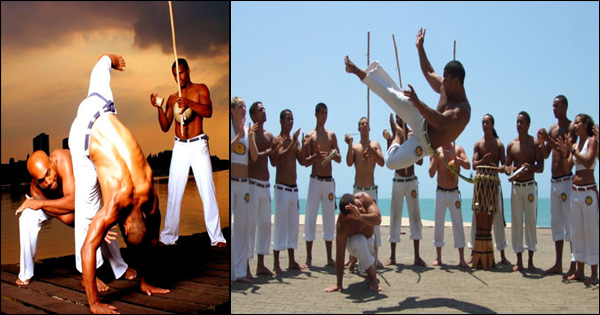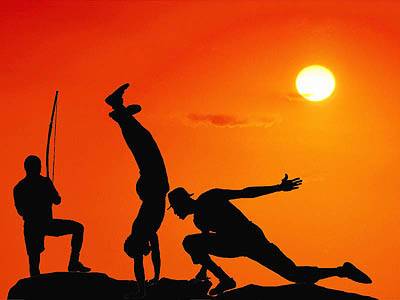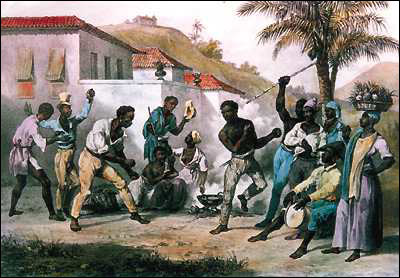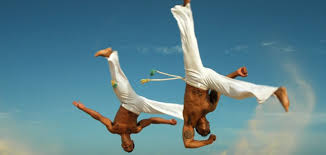This Martial Art Incorporates Dance and Acrobatics Into Its Movements Capoeira

Through song and trip the light fantastic toe, capoeira is the revolutionary symbol of Afro-Brazilians. Reduced to slavery, deprived of the correct to defend themselves, African and indigenous slaves volition develop a martial art fighting to free themselves from their enslave.
Capoeira: A History of an Afro-Brazilian Martial Art
What is Capoeira?
 Capoeira is an Afro-Brazilian martial art born in 1537, with the deportation of thousands of African slaves from Africa to work in sugarcane fields in Brazil. Drawing its roots in African dance and fighting methods, capoeira became a revolutionary symbol for Afro-Brazilians. With its playful and acrobatic side, capoeira mixes dance, singing and fighting.
Capoeira is an Afro-Brazilian martial art born in 1537, with the deportation of thousands of African slaves from Africa to work in sugarcane fields in Brazil. Drawing its roots in African dance and fighting methods, capoeira became a revolutionary symbol for Afro-Brazilians. With its playful and acrobatic side, capoeira mixes dance, singing and fighting.
Capoeira-similar forms are practiced in almost countries of the slave merchandise.
- The ladja or danmye in Martinique and Guadeloupe.
- Moring in Reunion, Madagascar and Mayotte.
- The susa in Suriname.
- The maní in Cuba.
- The pingue in Haiti.
What is the feature of capoeira?

Master feature of capoeira is the "roda. Indeed, the capoeirists course a circumvolve, a circle around two capoeirists who fight. This style of struggle mainly uses the feet, for the hands of the slaves were tied. While the two capoeirists clash, they sing and handclapping their easily to encourage them in a festive and joyful atmosphere. As before long as the fight ends, two others take over.
Different types of capoeira movements are jumps and acrobatics, movements of animals, movements on the basis and movements at mid-top. The basic move of the capoeira is the Ginga. The Ginga allows you to move in rhythm, like boxers and continuously.
What are the origins of capoeira?
 Origins of capoeira cause many disagreements and remain blurred. 2 movements clash.
Origins of capoeira cause many disagreements and remain blurred. 2 movements clash.
The first motion expresses that the capoeira came with the African slaves. For example, for Angolan slaves, capoeira was a dance of seduction used for pretenders of young women. Others explain that capoeira was inspired past the fighting techniques of Kongo Kingdom (Republic of angola, Democratic republic of the congo, Congo-Brazzaville and Gabon). This fighting art of the warriors was called«NGO-LO » in French, the strength of the panther, this being the historical totem of the KONGO people), according to the Society of Historians of Republic of the congo. The testimony of Albano de Neves and Souza via Fifty. Camara Cascudo confirms this idea.
Second movement says that capoeira was born in Brazil. Of form, it has been refined by African slaves, but it is created in Brazil.
A famous master of the capoeira mestre Bimba declares to the newspaper 'Tribuna de Bahia' in 1969:
It was in the senzalas of the Reconcavo that the Capoeira was born. »
Every bit for the African and Angolan origin of the capoeira he states in the same newspaper:
The blacks, aye, were from Angola, but the Capoeira is from Cachoeira, Santo Amaro and Maré Island. »
Capoeira: a revolutionary symbol of Afro-Brazilians?
 Chained, abused, African slaves developed a martial art to defend themselves from their oppressors. In order non to get defenseless, they used cunning in disguising this martial art by singing and dancing. They trained daily to the rhythm of percussion to prepare for a rebellion to gratuitous themselves from their Portuguese settlers. Exhausted physically, they secretly develop a traditional struggle that volition release them one 24-hour interval from their chains.
Chained, abused, African slaves developed a martial art to defend themselves from their oppressors. In order non to get defenseless, they used cunning in disguising this martial art by singing and dancing. They trained daily to the rhythm of percussion to prepare for a rebellion to gratuitous themselves from their Portuguese settlers. Exhausted physically, they secretly develop a traditional struggle that volition release them one 24-hour interval from their chains.
Some slaves manage to escape and form Quilombos, that is, hidden communities that alive in forests. To defend themselves from the colonists, they utilise capoeira. The well-nigh famous Quilombos "O Quilombo dos Palmares" has been held for more than a century. It is celebrated and the most famous of the Resistance is "Zumbi Dos Palmares", an indisputable effigy of the resistance of the African slaves.
Capoeira can be divers equally a traditional struggle through gestures and blows, a cultural manifestation with songs and dances, simply also an acrobatic game between capoeirists.
In exchange for their freedom, during the Paraguayan state of war, Brazil sent many capoeirists fighting on the battlefield.
In 1890, Brazil created an offense to prohibit capoeira. Anyone who was surprised to practice capoeira was guilty of "capoeiragem." Their punishments were terrible, for they were imprisoned and sent to forced labor.
For years, it was crafty to make capoeira. It was practiced secretly. The cap of the cavalry was played to warn the capoeirists of the arrival of the colonists and allowed them to flee.
Towards the beginning of the twentieth century, it was the democratization of capoeira. Information technology is gaining more and more popularity. Capoeira has get a respectable and democratic art. It is supported massively past many artists, dancers, Brazilian public men. It is the symbol of the revolution, rebellion of the Afro-Brazilians towards their oppressors. It is a popular manifestation of Brazilian culture. In addition, capoeira leads to the creation of a school to learn this art.
| Traditional or Angolan capoeira. | Regional capoeira |
|
|
Finally, in 1940, capoeira was legitimate. The police prohibiting it was repealed. Thank you to the work of Mestre Bimba and Pastinha, capoeira leaves the image of clandestinity and becomes a legitimate sport. Today, it is one of the about expert sports in Brazil after football, Brazilian jiu-jitsu and volleyball. It is a cultural effect, office of the heritage of Brazilians. It expresses its identity, its history and the Afro-Brazilians' combativeness. The values of capoeira are numerous. She develops physical stamina, agility, flexibility and a sense of rhythm in a very warm temper.
The phrase that defines capoeira by many people is that it is the art of fighting inside the dance and dancing in the fight. "
Do you like this sport?
Source: https://afroculture.net/capoeira-a-history-of-an-afro-brazilian-martial-art/
0 Response to "This Martial Art Incorporates Dance and Acrobatics Into Its Movements Capoeira"
Enregistrer un commentaire